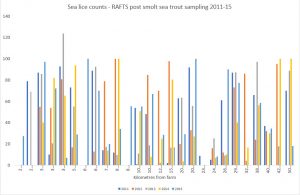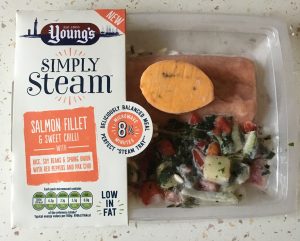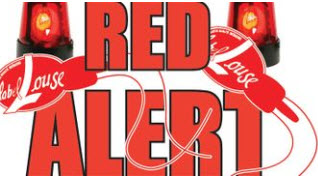Forty years: The Scotsman newspaper raised concerns from ‘campaigners’ that the salmon farming industry is in crisis and should not be allowed to expand without serious consideration of the environmental impacts and risks to coastal livelihoods.
Members of the Coastal Communities Network (CCN) have said that the industry should not expand until the detrimental impacts of salmon farms are addressed. These include:
- Pests and disease that can be passed onto wild salmon and sea trout
- Escapes of farmed fish which can breed with wild salmon.
- Pollution from waste
- Toxic chemicals and medicines which can kill off crabs and lobsters that are important o local fishing fleets
- Predator control methods including the shooting of seals and use of acoustic deterrents which are illegal as they harm whales and dolphins
- Spoiling wild landscapes affecting tourism
Similar accusations of environmental damage were levelled at the salmon farming industry during both Scottish Parliamentary enquiries but like this latest attack on the salmon farming industry, the evidence supplied to these enquiries was rather thin on the ground. In fact, given that the salmon farming industry has been in operation for over forty years, there now must be plenty of hard evidence to support any claims that the salmon farming industry is causing environmental damage. Rather than quote scientific papers based on mathematical models would it not be better to see visual evidence of specific incidences of this environmental damage. If the salmon farming industry is as damaging as they claim then after forty years, there must be numerous examples across the west coast and the islands for everyone to see. However instead of specifics, all that is heard is the usual whingeing and whining of a small number of campaigners who would probably prefer to see the west coast as a wild wilderness with a few rural communities living in isolation rather than seeing the region as a living and breathing part of a successful Scotland.
CNN were supposed to meet the Environment Minister, but the meeting was postponed prompting this latest criticism. The Minister wants CNN to meet Marine Scotland again even though they met with them in July. At that meeting, Marine Scotland admitted to CNN that salmon farming has an impact on the environment. This is not surprising, given that Marine Scotland told us in July that salmon farming does have an impact on wild fish. Marine Scotland haven’t told CNN if the harm is significant. We suspect that they don’t know. In relation to sea lice and wild fish, their evidence in some international scientific papers, but these have little bearing to what is happening in Scottish waters. It is worth remembering that Marine Scotland Science have spent the last three years and £610,000 and cannot say that sea lice do have an impact on wild stocks. We, at Callander McDowell, will be discussing this work in the coming weeks.
CNN told the Scotsman that Marine Scotland’s inaction on salmon farming could bring about the demise of wild salmon, yet we at Callander McDowell would argue that just because wild fish catches have declined on the west coast does not mean that salmon farming is to blame. We still have not had a single reply to our graph that shows wild fish in decline along the west coast for thirty years before the arrival of salmon farming. Even Marine Scotland Science don’t seem willing to explain why salmon farming is responsible.
We do acknowledge that there are videos of the sea bed under salmon pens that show organic waste. What is not made clear is that the area covered is just under the nets whilst the area just metres away is relatively free. The sea bed does recover when the pens are removed. Of course, in strong tidal areas, the waste does get spread over long distances but as in any ecosystem nutrients do get recycled.
In all, it is estimated that salmon farms cover an area the size of two eighteen-hole golf courses. This is hardly a speck in the ocean.
It doesn’t seem to matter what response is offered by the salmon industry to these claims of environmental damage. The industry is accused of obfuscating or even of lying. Critics don’t want to hear anything but their own view. We, at Callander McDowell now believe it is time for these critics to come up with hard proof of the damage they claim exists, not just anecdotal evidence.
After forty years, surely there should be sufficient proof of how much the salmon industry impacts on the environment.
Reality v. Make-believe: We are still awaiting the report from the Scottish Parliament’s Rural Economy Committee following their enquiry into the salmon farming industry. The anti-salmon farm lobby are still busy trying to influence committee members with postings of comments and videos. One of the latest video contributions comes from long-time anti-salmon farming campaigner Don Staniford. Certainly, some politicians take note of Mr Staniford as his efforts fuel their existing dislike of the salmon farming industry.
Recently, Mr Staniford has been posting videos shot outside the premises of various salmon farming companies. His latest video was shot as he skulked around the perimeter fence of Marine Harvest’s processing plant in Fort William. What is evident form the video is that Mr Staniford is adept at manipulating the reality to fit his own views. For example, in this posting he videos a stack of fresh fish tote bins. These are widely used in fish processing plants, but Mr Staniford describes them as mort bins with the number reflecting the scale of mortality experienced by the salmon farming industry. Why a processing plant would have a large stack of mortality bins is unclear since any mortalities would never come within miles of a fresh fish processing plant. His claims are simply nonsense.
Mr Staniford has a history of twisting the facts to suit his own purposes. In 2012, he was accused of defamation for making false claims against a salmon farming company in a Canadian Court. It is worth remembering the comments made by the judge – The Honourable Madam Justice Adair of the Supreme Court of Canada:
“Mr. Staniford demonstrated his disrespect for witnesses and his disdain generally for the court and the judicial process.”
“Mr. Staniford looked on the trial as an opportunity to get his message out, and he did not hold back. For example, in Internet postings during the trial, Mr. Staniford demeaned and mocked the physical appearance of three of Mainstream’s witnesses, Mary Ellen Walling, Leanne Brunt and Dr. Gallo.”
“Mr. Staniford explained that he likes to use what he perceives as humour, and that, as far as he is concerned, it is entirely fair to criticize, lampoon and spoof people he perceives to be public figures.”
“I have concluded that Mr. Staniford is akin to a zealot. Virtually anything that conflicts with his view and vision is wrong, bad, disgraceful and worse. Individuals who work in the salmon farming industry do jobs that are “nauseating.” He is highly suspicious. Neutral facts (for example, that at one time the BCSFA used the public relations firm Hill & Knowlton to do some work for it) will lead him to jump to irrational conclusions.”
“Mr. Staniford seems incapable of conceding he might be wrong on some things. He is devoted to a cause where salmon farming is thoroughly bad, with no possibility of redemption, and must be eradicated. To concede that salmon farming might have some value would mean that Mr. Staniford has wasted a good part of his adult life. He believes his own press, even when contradicted by other, contemporaneous documents.”
“During the trial, Mr. Staniford showed that he is extremely uncomfortable about having his views questioned. He was defensive, aggressively argumentative and insulting during his cross-examination. Even during his examination-in-chief, he demonstrated that he is a bad listener, and he often used questions as an opportunity to make speeches, rather than giving responsive answers. Although Mr. Staniford claims to be a champion of free-speech, he cruelly and publicly mocks people who have a different point of view (e.g., Ms. Walling and Ms. Brunt). His use of what he calls “humour” and “spoofing” is an example of strong passive aggression. In fact, he is aiming to ridicule and humiliate people who do not agree with his views. He sees that as a way of promoting his campaign.”
First look: Marine Scotland have just updated their ‘Summary of Science’ in relation to sea lice, salmon farming and wild fish. We, at Callander McDowell, have questioned some of this science in a previous issue of reLAKSation and plan to continue the questions in forthcoming mailings – see http://www.callandermcdowell.co.uk/relaksation/relaksation-no-880/
The Summary of Science https://www.gov.scot/Topics/marine/Salmon-Trout-Coarse/Freshwater/Research/Aqint/troutandlice has been updated to reflect the new acceptance that sea lice have an impact on wild fish. We will be looking at the additional papers included in the summary as time allows but we notice that the paper by Stuart Middlemas remains in the section titled ‘Is there an association between levels of lice on salmon farms and sea trout?’ The text states that ‘Data collected throughout the west coast of Scotland showed that the proportion of individual sea trout with sea louse burdens above a level known to cause physiological stress decreased with distance from that farm (Middlemas et al. 2013)‘.
This conclusion was reached by examining the number of lice on sea trout collected by a number of fisheries trusts at selected sites along the west coast. Dr Middlemas used data collected before 2010 in his analysis. The fishery trusts have continued to collect this data and that from 2011 and 2015 was published by the Rivers and Fisheries Trusts of Scotland (RAFTS). We examined the data and plotted the lice counts for all life stages using different parameters from all the sites graphically. Most importantly we aligned them in order of distance from a farm. Therefore, those on the left are nearest a salmon farm whilst those on the right are the furthest distant. There are a number of graphs, but to keep this simple, the graph shown sums up our conclusion. Whilst Dr Middlemas concluded that salmon farms would not exert an influence on lice numbers over 31km and those sampling sites nearest a farm would likely have a greater infestation.

In our opinion, the graph covering a five-year period shows no pattern and it seems just as likely that sea trout from over 50kms away might have similar sea lice counts to those nearest the farm. Of course, we have not had any feedback from Marine Science Scotland to clarify their findings.
We have also questioned the findings of Moore (2018) which came to a similar conclusion as Middlemas even though the sampling from the sites nearest the farms produced the lowest sea lice counts.
We shall be delving deeper into the depths of the science in the coming weeks.
More Spey: If you’re an angler, then the Fishing Report for the River Spey in the September issue of Trout and Salmon magazine doesn’t make for great reading. According to the report, the Spey Fishery Board have issued the following notice: “The Spey Fishery Board acknowledges that this yea’s spring salmon catches have been particularly poor and that there is widespread concern about the decline in the numbers of adult salmon returning to the river. The Board is very conscious of the impact this situation has on the angling experience and is also keenly aware of the economic impact of the continuing decline. It is important to recognise that this situation is not confined to the River Spey; indeed, the problem is replicated Scotland-wide”.
The report says that the Board will be liaising closely with other Salmon Fishery Boards, Fisheries Management Scotland and the Scottish Government to assist with any worthwhile initiatives aimed at tackling this national problem. Meanwhile, the Board has asked the Spey Scientific Committee to consider the options.
Malcolm Newbould, who wrote the fishing report says that social media is already full of people demanding the removal of the science as a basis for running the river. Instead, there is a demand for the removal of all fish-eating birds, seals and even dolphins!
The trouble for the Spey and other east coast rivers, is that there may not be any easy solution. The problem with the angling sector is that they tend to look at themselves in isolation rather than how they interact with the natural world. It is clear that climate change is beginning to have significant impacts on the planet from the poles to the equator. There have been numerous reports that fish species normally seen in the Mediterranean are being observed around Scotland. At the same time, colder water species are moving north to escape warming waters. Why would Atlantic salmon be immune from these changes? Instead, it is easier to lay the blame with predators such as birds and seals which are now protected. We have even read that the decline in Spey catches is due to the presence of salmon farms in Orkney and Shetland.
We have repeatedly pointed out that should stringent controls ever be placed on salmon farming, there will be no concurrent return of wild salmon to Scottish rivers. Salmon farming is not the problem.
In the Pink – taste test: Young’s have recently launched two new frozen microwave steam dishes, one with Pink salmon and the other with haddock. The 300g packs retail at just £3. The Pink salmon variety is described as Simply Steam salmon fillet & sweet chilli with rice, soy beans, & spring onions with red peppers and pak choi.

The tray is removed from the card outer and placed in the microwave without piercing. It couldn’t be simpler. However, it is not unique as we have previously tasted chilled versions, although without accompaniments that also go straight into the microwave.
After just under ten minutes, including standing time, the dish is ready to eat. So, what did we think?
We have often heard on TV cooking programmes like the Great British Menu, where chefs will taste something and say that they are not sure about an ingredient and hope that it will come together in the whole dish. In a similar way, we found nothing too objectionable with the three different parts of the dish, we just didn’t think that they came together to make an attractive meal. It was a bit like eating three different dishes.

The pink salmon, like other Pacific salmon was dense but after the incorporation of the sweet chilli butter that melted across the flesh as it cooked, ate much better than some other pink salmon dishes. In our opinion, what was lacking was a sauce to bring the dish altogether.
It will be interesting to see how well this dish does in retail. It is located in the freezer cabinet with other meal dishes. Freezers are not the most visited area of most supermarkets, so the dish has a big hurdle to overcome even before being tasted.


